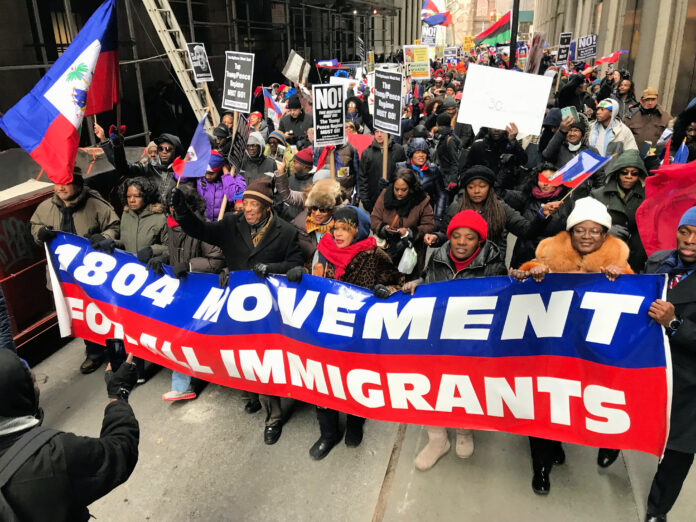
Haitians and Haitian-Americans are not exempt from the U.S. government’s long history of overt oppression against Black and Brown people, both abroad and at home. So it’s no surprise that the Haitian community became the target of out-going U.S. President Donald Trump’s ire and scorn.
Born into New York City’s real-estate elite, Trump came to prominence in the 1970s and 1980s, gaining notoriety in a city that was experiencing a large influx of non-White immigrants from Asia, the Caribbean, and Latin America. Haitians and other Afro-Caribbean people began settling in neighborhoods that were closed off to Black people before, resulting in a massive White flight that created overnight demographic shifts in neighborhoods throughout Brooklyn and Queens. Indoctrinated to see housing as the ultimate sign of privilege, many White Americans see Black neighbors as being synonymous with property value decline and crime. In their mind, their proximity to Black people, both physically and financially, determines their social standing.
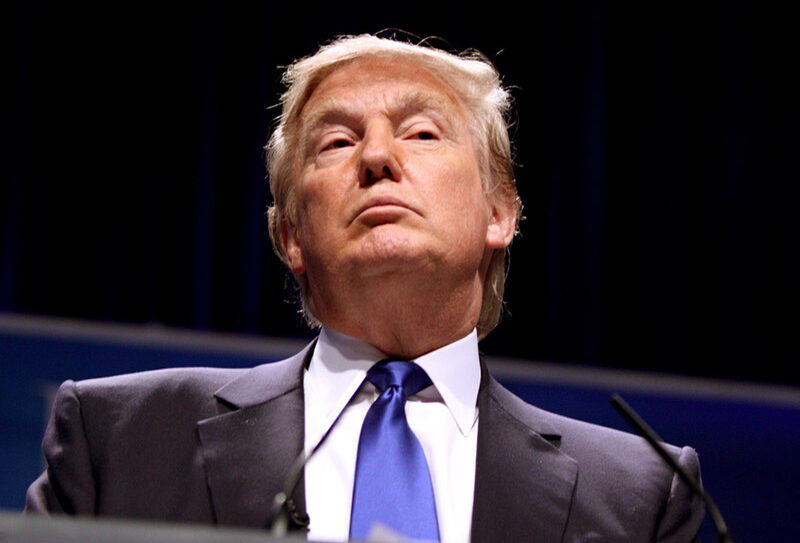
A Black person’s national or regional identity had little bearing on the decision of a real-estate firm or bank to deny housing opportunities. This was especially true in New York, where just the rumor of Black people moving into a neighborhood would send whole blocks fleeing to the suburbs, whether the incoming residents were Haitian, Jamaican, or African American.
In real-estate, as with every other commodity, the less available housing is, the more valuable it becomes. Drawing value from scarcity is a feature of capitalism. In reality, there is more than enough housing for everyone. Housing scarcity is a myth manufactured by real-estate capitalists because for every one homeless person there are at least five vacant homes. In New York City, there were 3 vacant apartments for every one homeless person before the pandemic, and new luxury apartment buildings continue to be built.

For decades the industry embraced red-lining, a practice that kept Black and Brown people hemmed up in neighborhoods with decaying infrastructure and housing. The same institutions denied them access to the capital needed for investments to make repairs or purchase their own property. Trump and his family are a product of this world and faithfully adhered to its code, upholding apartheid in New York City. Trump’s stardom in the 1980s came during a time when there was an intense xenophobic media campaign against the Haitian people, many of whom were arriving by boat in South Florida.
The Reagan Administration was working with Jean-Claude “Baby Doc” Duvalier to make sure Haitian refugees weren’t finding asylum in the U.S. as Cubans automatically did. Adding salt to the wound, the Center for Disease Control (CDC) unscientifically declared Haitians a group at high-risk for AIDS and barred blood donations from people of Haitian ancestry. The narrative even said that Haitians brought AIDS to the United States, a claim which has since been proven false. New York City at the time had the largest and oldest Haitian community, and its rising real-estate mogul Trump was fully aware of these tropes. Along with being racist and xenophobic generally, Trump also made specific policy decisions and comments that deeply impacted the Haitian-American community.
Trump dispelled any illusions through his increased support to Jovenel Moïse’s puppet regime in Haiti and his racist, inhuman, aggressive immigration and domestic policies.
During a 2017 meeting with his cabinet, Trump expressed disgust that 15,000 Haitians had received visas the previous year, saying “they all have AIDS,” according to the New York Times. Trump’s officials also tried to concoct a false and racist narrative that Haitians with Temporary Protected Status (TPS) had criminal tendencies, to justify termination of their protection. Trump made a “Public Charge” rule change, under which anyone who relied on public assistance (Medicaid, food stamps, public housing, etc.) would not be eligible to apply for a green card, either for themselves or for someone else. In January 2018, he called Haiti (and other nations) a “shithole,” prompting vigorous demonstrations from the Haitian community and its allies. Trump carried out countless other executive actions that harshly impacted the Haitian community, as well as immigrants and Black people in general.
On the campaign trail, Trump traveled to Miami’s Little Haiti to say that he would be Haitians’ “biggest champion” and not mistreat Haiti as Bill and Hillary Clinton did. “Taxpayer dollars intended for Haiti and the earthquake victims went to a lot of the Clinton cronies,” Trump said.
This phony posturing may have garnered Trump a few votes from South Florida’s Haitian-Americans in 2016. But after he took office, Trump dispelled any illusions through his increased support to Jovenel Moïse’s puppet regime in Haiti and his racist, inhuman, aggressive immigration and domestic policies.
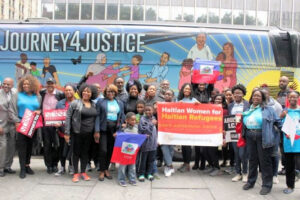
Trump’s assault on Haitians was so bad that the community took legal action. In January 2018 in New York, Haiti Liberté and Miami’s Family Action Network Movement (FANM), with others, sued Trump and his officials for their “ arbitrary and capricious agency action” in terminating Haitians’ TPS (Saget v. Trump). In April 2018, the Flatbush-based Haitian Women for Haitian Refugees and the Haitian Lawyers’ Association joined the NAACP’s lawsuit in Washington, DC against Trump’s Department of Homeland Security (DHS), charging “larger, racialized goals concerning immigration” (NAACP v. DHS). These two lawsuits and seven others helped prevent Haitians and other nationalities from losing their TPS. Blocked by judges on TPS, Trump stepped up his offensive on other fronts. He ramped up President Obama’s practice of deporting Haitians arriving at the U.S./Mexico border and speed up the deportation of Haitians already slated for removal due to criminal cases dating back decades.
For example, in the early 1990s, Jean Montrevil was a Haitian teenager caught in a drug case in Virginia. After serving 11 years in prison, he returned to New York where he did community organizing, got married, had children, and lived his life as a law-abiding citizen. All the while, he was fighting immigration detention and repatriation. He was almost deported in 2010 until the Jan. 12th earthquake in Haiti put a stop to his removal. Jean would continue to organize and advocate for immigrants, which likely placed him high on ICE’s removal list.
In January 2018, Jean was deported back to Haiti. He was among 35,000 Haitians who were slated for deportation in 2010, many for reasons similar to his own. Regardless of time served and a good record, both Democratic and Republican administrations fought to deport Jean, but it took Trump to finish the job Obama started.
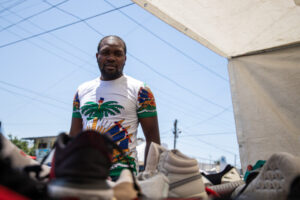
According to the Haitian Bridge Alliance, a California based non-profit that works with Haitian migrants arriving at the southern border, 1,200 Haitian asylum seekers were deported in October 2020 alone. Many of those deported endured a perilous journey traveling from Brazil and Chile by foot to the U.S./Mexico border. These mass deportations did not begin with Trump. They began in 2016 under Obama when thousands of Haitians began showing up in Tijuana. Under first Obama then Trump, the U.S. built the world’s largest system of cages for immigrants. So Haitian deportations under Trump were facilitated by the fact that the U.S. has had a long practice of denying Haitians asylum at the rate of 80-90% regardless of the violence they’d face at home. Trump could not have threatened the TPS status of 60,000 Haitians if previous administrations had created a path to permanent residency. As an immigration advocate, I spoke to the offices of Sen. Chuck Schumer and Rep. Yvette Clarke back in 2017-18. At the time, they did not think it was worth pushing for permanent residency. Then Nydia Velasquez’s American Dream and Promise Act began to gain momentum.
It is important for us not to be awestruck by Haitians in positions of power and influence and remind them that they are accountable to us as a community
Trump would not have been able to carry out his racist agenda towards Haitians and other Black and Brown people had it not been for the symbiotic relationship of White supremacy and capitalism in America. Today, the real estate elite that birthed Trump is gentrifying the same communities they once decimated through red-lining. In fact, Trump has deep real-estate roots in both New York and South Florida, home to the largest Haitian communities in the United States. These same communities are under attack by real-estate sharks in league with Trump, who push rezoning laws, support more police funding and occupation, and pay for local and state political campaigns from both ruling parties, often Haitian-American politicians.
Since Sep. 11, 2001, immigration laws have become much more stringent. Even family reunification has become extremely difficult. More Haitians must live in the shadows. The community is more vulnerable to deportations through economic deprivation, police occupation, and the perpetual statelessness of newcomers. Although he made things worse, these conditions are not Trump’s doing; they are the byproducts of capitalism and White supremacy. Previous administrations and local and state politicians handed many tools and precedents over to Trump, empowering him to wreak havoc over the past four years.
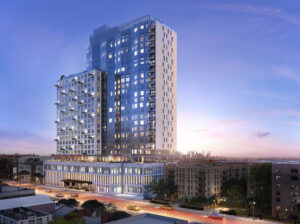
To combat their oppression, more Haitians must become conscious of the class war raging around them. Many Haitian-Americans who are middle class or have residency/citizenship status are not aware of the plight faced by those who are poorer or have no status or both. It is important that we uplift networks and organizations that provide support and mutual aid to those of us in our communities who don’t have the economic means or language skills to navigate this society. In New York, people can build with organizations like Haitian Americans United for Progress (HAUP) and Haitian Women for Haitian Refugees, to name two. It is important for us not to be awestruck by Haitians in positions of power and influence and remind them that they are accountable to us as a community, especially the poorest among us.
We must also demand that Haitian-American politicians do more than just uplift the Haitian community symbolically. They must help empower the community in concrete ways, by fighting for housing, economic, and labor rights.
Most importantly, we Haitians must ignore and put to death narratives that cause divisions between ourselves and other Black people and oppressed people in general. This only makes us weaker. Rodneyse Bichotte once said: “Haiti is in the Caribbean, but not of the Caribbean.” But when police officers killed Patrick Dorismond in 2000, no one cared from which country he came when they profiled him. His skin color was enough to issue the death warrant.
Ayibobo!









